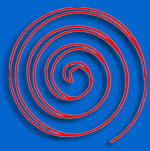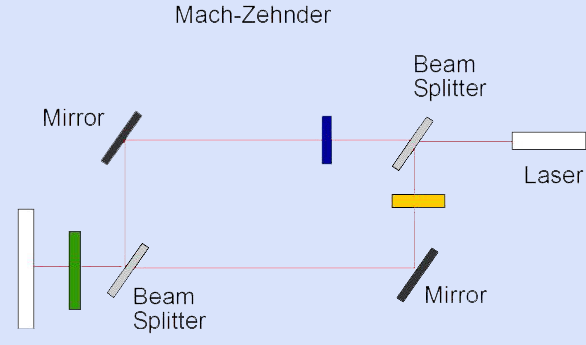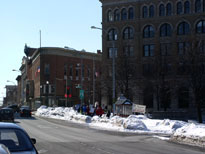
Quantum Measurement
Measurement
Statistics & Uncertainty Estimations
Heisenberg's Uncertainty Principle
Relativity Theory & Causality
Spin, Polarization, and Mixed States
- Polarization
- Spin
- Mixed State
- Questions
Bell's Inequality
Spin and Mixed Quantum States
Polarization
 In light direction of oscillation of its electric field determines
light's state of polarization. If we were to visualize light's electric
wave oscillations same as a propagating water wave, then when the
(electric) wave oscillation go up and down in a vertical direction we
say that the light is vertically polarized. If, on the other hand the
(electric) wave oscillation is horizontal, then we say that the light is
horizontally polarized. Any other direction of polarization, then, is
just a linear combination of these plane polarizations. We call these
polarizations in which the plane of oscillation remains fixed in space
linear polarization. If, on the other hand, we can have a situation in
which the plane of oscillation rotates from a vertical to a horizontal
and back to a vertical direction as the light travels in space, this
leads to an elliptical or a circular polarization that can be left or
right handed. Visit the
Physics 2000
site for excellent applets on the topic of polarization of light.
In light direction of oscillation of its electric field determines
light's state of polarization. If we were to visualize light's electric
wave oscillations same as a propagating water wave, then when the
(electric) wave oscillation go up and down in a vertical direction we
say that the light is vertically polarized. If, on the other hand the
(electric) wave oscillation is horizontal, then we say that the light is
horizontally polarized. Any other direction of polarization, then, is
just a linear combination of these plane polarizations. We call these
polarizations in which the plane of oscillation remains fixed in space
linear polarization. If, on the other hand, we can have a situation in
which the plane of oscillation rotates from a vertical to a horizontal
and back to a vertical direction as the light travels in space, this
leads to an elliptical or a circular polarization that can be left or
right handed. Visit the
Physics 2000
site for excellent applets on the topic of polarization of light.
The polarization of light does not affect either its energy or its momentum. But it does determine in what way the light wave can conduct its influence. For example, charges that can only oscillate in a vertical direction will not be effected by a horizontally polarized light, because this light can only cause oscillations in the vertical direction. So, a vertically polarized light would pass unaffected through such a medium. In the case of an elliptically polarized light falling on the same charge would only have the vertical component of its electric oscillation absorbed; the horizontal component will remain unchanged.
When we reduce the light intensity to its smallest possible level, then we are dealing with one single photon - the quantized light. At the photon level, the "polarization" is related to its so called (intrinsic) angular momentum (spin). Photons, it is discovered, come in two varieties: left handed or right handed angular momentum. This quantized, state of the photon is referred to as its helicity or its spin. So, in reality, the intrinsic polarization of photon is purely circular; either right (R-state) or left (L-state) circular polarization.
 As a consequence, linear polarized light must be made of a
combination of left and right circular polarized photons. But now the
troubling question comes: what happens when we reduce the intensity of a
linearly polarized light beam further and further to the point that we
end up "with one photon at a time"? Its polarization state, we know, has
to be measured to be either left or right circular polarization; but the
beam's polarization (linear) needs to be a mixture of both
of these!
As a consequence, linear polarized light must be made of a
combination of left and right circular polarized photons. But now the
troubling question comes: what happens when we reduce the intensity of a
linearly polarized light beam further and further to the point that we
end up "with one photon at a time"? Its polarization state, we know, has
to be measured to be either left or right circular polarization; but the
beam's polarization (linear) needs to be a mixture of both
of these!
Experiments dealing with this single photon picture find the following to be true. The photon turns out to be right or left circularly polarized with a probability that is equal to the admixture of these polarizations required to make up the polarization of the original beam of light. For example, If our original beam were linearly polarized, we could construct this polarization with an equal number of R and L state photons. Then the probability that a single photon would be left or right circularly polarized is 50%. What is interesting, however, is that experiments have verified that in fact this 50% probability is not the probability of the ensemble (collection of photons), but the probability for each individual photon! What this means is that every single photon, in this linearly polarized light, is in an equal mixture of the R and L intrinsically pure spin states! [A recent article in the American Journal of Physics by Mark B. Schneider and Indhira A. LaPuma (Amer. J. of Phys., 70, No.3, March 2002, pp. 266) outlines their clever experiment that examines this odd feature. ]
Spin
 Aside from photon, other elementary particles such as electron,
proton, and even neutron also have the property or attribute that we
call spin. This property has no clear explanation in classical (i.e.
non-quantum) physics. It is, as in the case of photon's, related to the
angular momentum type properties. The photon spin state is tied to its
direction of propagation. So, a photon that goes into the page is
measured (notice that I'm not saying "is"!) to be either R or
L. If it is in the R-state its angular momentum is
counterclockwise; while if it turns out that it is in the L-state,
then its angular momentum is clockwise. The spin of the electron is also
quantized, but the quantization direction has nothing to do with the
direction of motion of the electron. More specifically, its spin can
have three separate independent directions, as in the x, y, and z-axis.
It is the direction of an external magnetic field that decides the
quantized spin directions. A vertically oriented external magnetic field
causes the electrons interacting with this field to have their spin
point up or down; i.e. their spin polarization direction becomes
vertical. (This is because the magnetic moment of the electron interacts
with the external magnetic field.) Similar quantization directions are
dictated by external magnetic field directions for other particles,
including the neutron's.
Aside from photon, other elementary particles such as electron,
proton, and even neutron also have the property or attribute that we
call spin. This property has no clear explanation in classical (i.e.
non-quantum) physics. It is, as in the case of photon's, related to the
angular momentum type properties. The photon spin state is tied to its
direction of propagation. So, a photon that goes into the page is
measured (notice that I'm not saying "is"!) to be either R or
L. If it is in the R-state its angular momentum is
counterclockwise; while if it turns out that it is in the L-state,
then its angular momentum is clockwise. The spin of the electron is also
quantized, but the quantization direction has nothing to do with the
direction of motion of the electron. More specifically, its spin can
have three separate independent directions, as in the x, y, and z-axis.
It is the direction of an external magnetic field that decides the
quantized spin directions. A vertically oriented external magnetic field
causes the electrons interacting with this field to have their spin
point up or down; i.e. their spin polarization direction becomes
vertical. (This is because the magnetic moment of the electron interacts
with the external magnetic field.) Similar quantization directions are
dictated by external magnetic field directions for other particles,
including the neutron's.
Mixed State
We have already discussed this concept in the context of the photon polarization. Evidently, microscopic systems such as elementary particles and atoms behave as if any of their properties is made of a "mixture" that is not directly measurable. What we can measure is one state (quantized value of the property) or the other, but not the mixture. However, experimental evidence shows that the mixture does exist! An example of this is demonstrated in the "which-way" experiment. In fact, these experiments seem to suggest that in these cases causality can be violated. To see how this can happen, let us examine the experiment of Schneider and LaPuma involving photon polarization.
This experiment utilizes a Mach-Zehnder interferometer to create interference fringes from a randomly plane-polarized (i.e. a circularly polarized) laser source. This type of interferometer is made of two beam-splitters and two mirrors that first breaks a laser beam into two separate beams, and later overlap these two beams to create an interference pattern on a screen (here, a video camera). In addition to the beam splitters and the screen there are two polarizers and one analyzer used in this experiment. The polarizes are used in a crossed fashion one in each leg of the interferometer. The analyzer is placed just before the screen.

 In above diagram the yellow polarized is adjusted for horizontal
polarization and the blue one for vertical polarization. When the green
analyzer is oriented for horizontal polarization (or for vertical
polarization) then no interference is observed. However, when it is
oriented at 45o, one of the so called eraser orientations, then the
interference appear. This demonstrates that when the polarizer-analyzer
combinations "perform the experiment" to determine the polarization
direction of the light (photon) that passes in each arm, then the
"mixture" state becomes definite. However, when the analyzer is in the
"eraser" orientation, then despite the fact that cross polarized lights
do not interfere, the interference pattern appears. This clearly shows
that the photons are in a mixed state until detected. For a details on
this experiment as performed at Union and its results see:
Photon Quantum Eraser Experiment.
In above diagram the yellow polarized is adjusted for horizontal
polarization and the blue one for vertical polarization. When the green
analyzer is oriented for horizontal polarization (or for vertical
polarization) then no interference is observed. However, when it is
oriented at 45o, one of the so called eraser orientations, then the
interference appear. This demonstrates that when the polarizer-analyzer
combinations "perform the experiment" to determine the polarization
direction of the light (photon) that passes in each arm, then the
"mixture" state becomes definite. However, when the analyzer is in the
"eraser" orientation, then despite the fact that cross polarized lights
do not interfere, the interference pattern appears. This clearly shows
that the photons are in a mixed state until detected. For a details on
this experiment as performed at Union and its results see:
Photon Quantum Eraser Experiment.
Another interesting concept which has no analog in our macroscopic world, but exists in the microscopic world and is described by the theory of quantum mechanics is the entanglement. Entangled photon pairs are created in the laboratory using the method of "down conversion" in a nonlinear crystal. In this process an intense laser light creates two photons of half the energy from a single photon in the laser. In this sense, the photon's frequency is halved, or down converted. Similarly, there are atomic processes that create entangled "electrons". What is especial about these entangled entities? See the page on Quantum Entanglement.
